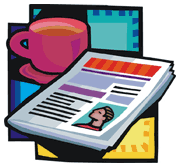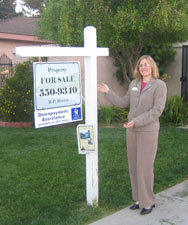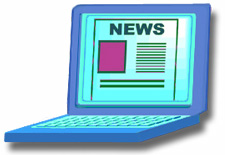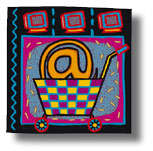“Using Newsletters as Communication
and Marketing Tools”
 Our
April 30th event was a fun and informal "Share & Compare Notes" occasion designed to help us all learn what our colleagues are producing in the way of business newsletters. Our
April 30th event was a fun and informal "Share & Compare Notes" occasion designed to help us all learn what our colleagues are producing in the way of business newsletters.
The presenters were people who regularly write or otherwise produce newsletters in print or electronic form. The presentations consisted of short, 15-minute overviews by the panelists describing the newsletters they publish, followed by a Q&A session where we discussed even more details.
We covered as many of the following highlights as we had time for:
- What are the benefits of producing a business newsletter?
- What are pros and cons of electronic vs. paper-based newsletters?
- What's required to produce a paper-based vs. electronic newsletter?
- How do you tailor content for your audience's interests and needs?
- What are the delivery challenges of e-mail vs. postal mail?
- What is an optimal delivery frequency?
- What caused you to start your newsletter?
- What business problem does your newsletter solve?
- Why did you choose paper rather than electronic, or vice versa?
- Who subscribes to your newsletter, and why?
- Has your subscriber list expanded over time?
- How much time do you spend producing your newsletter?
- Where do you get ideas for your content?
- What has occurred that you didn't expect?
This
session involved four segments in which four panelists provided details on their newsletter activities, as follows:
Paper-based newsletter publishers:
Electronic newsletter publishers:
Read the highlights and recommendations, below!
The Story Behind "The Update" by Lee Ferrero

The fundamental question to ask yourself, if you are considering whether to develop a newsletter, is this: "What business problem are you trying to solve?"
A newsletter is intended for two purposes: for the readers and for your organization. In a perfect situation, everyone benefits: the readers learn something new and the organization shows itself to the world in yet another dimension. Consequently, the readers are the richer for it and so are you and your organization.
Know exactly and precisely why you are motivated to publish a newsletter — because once you start it, you have to be prepared to keep doing it, even when there are times where you aren't in the mood or don't have the time. It is difficult to attract a readership but a little bit easier to lose them, and almost impossible to get them back a second time.
At the Private Industry Council, "The Update" newsletter has two major purposes:
(1) to put the PIC in a position whereby it is viewed as a viable information resource with content that is useful in everyday work; and,
(2) to present the PIC, as an entity, in the most positive light possible as a viable organization in the community and the State of California.
Where We Find Content
We use material and information as it arises, each month, and package it into the newsletter while also relating it to things happening locally — that month.
I seldom spend any time on the Internet looking for information; it's already there and people are already looking at it. I use old media as a resource and I package it in related and attractive ways with the old cut-and-paste style. This is not efficient but it is DIFFERENT from the current forms in play.
Comments We've Received
Here are some paraphrased, somewhat common remarks I hear from people who receive The Update:
- They like getting it in the mail
- They like having it sitting on the kitchen counter to look at in their leisure
- They like being able to take it to the coffee shop and reading it over coffee and a roll
- They make copies and put them in the internal office mailboxes (there is no copyright — in fact we encourage duplication and sending to more people).
People tell me they get tired of sitting in front of a computer screen all the time — they do like and value greatly, being connected. But the casual style is refreshing, most say.
How the Newsletter Is Organized
The Update is characteristically segregated into these pieces:
- Clean, open cover sheet with a cartoon and a paragraph about the contents inside.
- First page, maximum, talking unabashedly about great things the PIC is doing or just finished doing.
- Second page and maybe third, talking about local facts of interest in SLO County.
- Third page, onward, moves into newest trends, locally as well as state or nation; keeps on going with more trend and facts.
- The following pages get into new ideas being discussed and how they may impact work, and ways we do things.
The second half includes copies of especially leading-edge as well as old-fashioned "comeback kids" that are interesting and just now becoming known.
The average number of pages is about 25-30. No color, not double-sided but full of innovative and unusual information as well as big news items, but from a perspective that doesn't show up in the media. |
The Story Behind "Brown's Home Digest" by Regina Brown
 In "Rich Dad, Poor Dad," pages 132-133, author Robert Kiyosaki observes that the world is full of smart, talented people who will never be compensated for their talent... simply because they lack the necessary skill to market or "sell" themselves. In "Rich Dad, Poor Dad," pages 132-133, author Robert Kiyosaki observes that the world is full of smart, talented people who will never be compensated for their talent... simply because they lack the necessary skill to market or "sell" themselves.
It isn't good enough to have a great product, service, or company if no one knows about it! We must constantly market ourselves and keep our "name" out there at the top of people's minds.
For my real estate business, I mail out a 4-page newsletter approximately once every quarter. I usually print in black and white, but print in full color approximately once per year (it's about 5 times more expensive).
My audience is my 1,200+ contacts, known personally by my husband and myself. I focus on my audience and my personal message to them. I write (or edit) each article to fit my philosophy and style with my audience, and the theme for each issue.
Although it's a real estate newsletter, my focus is to help families better themselves economically through planning, saving, investing, and other financial strategies. I solicit articles from my favorite resources, such as mortgage lender, financial planner, attorney, accountant, etc.
I use a unique first-class stamp because:
(1) It substantially increases the likelihood that the newsletter will get opened, read, and saved (yes, some of my contacts save every issue in a binder)
(2) Unlike bulk mail, I receive the returned mail back from the post office, with a label showing the new mailing address, so I don't lose touch when folks move.
I started my contact database with 200 folks, and in 5+ years it has grown to 1,200 contacts. It is through talking to more people, developing connections, volunteering in the community, joining organizations, and mostly by networking, networking, networking! I participate in several networking events every month to meet new people and keep the contacts flowing into my pipeline.
Vendors I recommend:
- Local printer: Burdine Printing in Arroyo Grande
- Online printer: PostCardPress.com
- Software: Microsoft Publisher
|
The Story Behind "Boosting Business Performance" by Adele Sommers

I started my newsletter, “Boosting Business Performance,” about a year and a half ago with an invitation to about 60 friends and colleagues. The newsletter was something I had planned to do soon after launching my Web site as a way to increase visibility for my products and services.
Current Subscribers
I now have over 4,000 subscribers in at least 40-50 countries, including native English-speaking countries such as Canada, the US, Australia, South Africa, NZ, and the UK; and many other English-speaking populations in Europe, Scandinavia, and Asia. My list includes many subscribers in India and China; some in other surprising places such as Cuba, Kazakhstan, Romania; and others in a number of countries with really obscure country codes that I’d have to look up to identify.
The amount of interest from people around the world is definitely something I didn’t expect! Those international subscribers are all people who apparently are hungry for business-building information, which I assume is why they come to my site or subscribed from other online locations where I have my newsletter advertised. On good days, I get as many as 150 or more new subscribers.
How I Create Content
I choose and create content for four reasons, typically:
- It’s already part of my inventory of articles posted on my site
- In response to a request from a subscriber or a client
- To expand on a topic I’ve been developing into a product
- To address a subject on which I’m going to speak or give a workshop, such as this topic
The sample newsletter I provided as a handout for this meeting is actually about the subject of newsletters, and it gives my own answers to several items on our list of questions. (See the feature article below.)
The Production Process
My newsletter goes out every two weeks, and I spend up to 2.5 full days producing it each time. That’s because I do at least 6 or 7 distinct things to produce my newsletter, which is one reason it takes time to create:
- First I write the feature article and all the related chunks of content, and then I find the right graphics and edit them as needed (and I only use royalty-free stock).
- I next prepare the HTML e-mail version, using Dreamweaver to populate the custom template I use.
- I also prepare a plain-text, e-mail version, which will be sent out along with the HTML version. People have asked me why I use both formats. One reason is because a lot of subscribers prefer to receive only plain-text e-mail, as the images, etc., take longer to load. Not everyone has high-bandwidth Internet service, even in the US, so it’s important to consider your audience’s preferences. Another issue is that a number of newsletter producers have said that their delivery rates are higher with text-only newsletters, although I haven’t tried to verify that myself.
- Then I post the HTML version online, on its own Web page, and link it to my newsletter index where all of my back issues are available. I include that link to the online HTML version inside my plain-text e-mail newsletter, so people have a quick way to see the online version if they want to.
- Next, I often create a PDF version of the HTML newsletter. That makes it easy to distribute electronically, such as by e-mailing it to someone, or I can make it downloadable.
- Finally, I might also print it out, as I did to create handouts for this event. And do to that, I use the PDF version to print from. A printed copy is really great for occasions when I want to hand out something about a certain topic to a particular client or prospect, for example, or at a workshop or a meeting.
- Following that, I eventually extract the feature article from the newsletter and place it in the “Free Articles” section of my Web site.
In conclusion, using all of these options is a way I like to be able to “put it all together” and cover several different bases. It’s also a good example of using a classic information design technique — which is to create content once, and output it in many forms! |
“Tips for Using Newsletters as Communication and Marketing Tools” by Adele Sommers
How do you reach out to, and stay in touch with, your clients, customers, or colleagues? Do you have a way to keep your name, ideas, and offerings fresh in their minds at all times?
 A number of marketing studies have suggested that it can take at least 7-10 or more exposures to a given company, person, or message to generate a sense of familiarity and recognition in an audience. A number of marketing studies have suggested that it can take at least 7-10 or more exposures to a given company, person, or message to generate a sense of familiarity and recognition in an audience.
That could mean driving past a particular billboard every day for weeks, reading a certain newspaper ad multiple times, hearing buzz about someone in a radio commercial over and over again, or receiving a newsletter for several months -- you get the idea!
If you desire to create a bond with your constituents, you will want to provide them with a way to get to know, like, and trust you (also known as the "KLT" factor). This process leads to building loyal customer relationships over time. It involves finding a way to get onto your audience's "radar screens" at regular intervals -- and staying there. This article discusses:
1) Key benefits of producing a business newsletter
2) Pros and cons of paper-based newsletters
3) Pros and cons of electronic newsletters
4) Optimal delivery schedules
1) What Are Some Benefits of Producing a Business Newsletter?
A newsletter affords certain advantages over other types of media because it's a comforting, familiar concept modeled after a newspaper. Nothing tricky about it -- it can present facts, fiction, fun, advertisements, editorials, and many other types of content without requiring the audience to adopt a new mindset.
The text-oriented medium does not depend on audio speakers or video players to communicate.
You can emphasize tips and "how-to" information, case studies, and third-party endorsements, all of which convey the message that you care about your audience's success!
2) What Are the Pros and Cons of Paper-Based Newsletters?
 People generally create paper-based newsletters with desktop publishing tools, print them or have them professionally printed, and distribute them via the postal system or another method. The pros include: People generally create paper-based newsletters with desktop publishing tools, print them or have them professionally printed, and distribute them via the postal system or another method. The pros include:
- They provide a tangible and easily portable medium that subscribers can carry with them and read on a bus, plane, subway, or even in the bathtub -- without having to print out something first.
- They're unlikely to be discarded immediately, especially when they're attractively designed. Unlike hitting the "Delete" button, tossing a newsletter takes more deliberation, so there's a reasonable chance of it being read.
- They can be stored for future reference. Hint: Try distributing your paper newsletter already three-hole punched, which conveys to your audience: "Store this document in a binder!" You can even offer an attractive newsletter holder as a subscriber bonus.
The cons of paper-based newsletters include:
- Production and mailing overhead. Paper and ink (or professional duplication costs), the time to fold and label, and the postage all add up. If you produce in color rather than black and white, expect to pay several times more.
- Voluminous newsletters can appear wasteful. Some audiences might cringe at the idea of using so many trees if you regularly send a tome of information.
3) What Are the Pros and Cons of Electronic Newsletters?
People produce electronic newsletters (often called "ezines") in a variety of ways, including:
- A simple text-based e-mail message that is sent to a personal list or via a subscription broadcasting service such as ConstantContact.com, Aweber.com, or 1ShoppingCart.com (my favorite). Note that broadcasting services don't allow attachments.
 An HTML-based e-mail message with images and stylized text (like this one), which is distributed in the same way as a text-based message. An HTML-based e-mail message with images and stylized text (like this one), which is distributed in the same way as a text-based message.
Tip: Good broadcasting systems should allow you to transmit both HTML and text versions at the same time, using a "mime" function. It will automatically detect the recipient's preference for HTML or text e-mail, and present the correct version accordingly.
- A Web page where the newsletter is posted for posterity. (See examples.) Some newsletter producers send nothing more than a short, text-only e-mail that contains a link to an HTML or PDF version posted online.
The pros of electronic newsletters include:
- They have low production costs. Other than the time to produce them and the broadcasting service charges, there are currently no mailing fees involved.
- Delivery time can be close to instantaneous, unless there are server slow-downs or gateway blockages along the way.
- If formatted nicely, they can be printed to serve as handouts or examples of your professional communication style.
The cons of electronic newsletters include:
- Aggressive *spam* filters, which make it very tricky to write content that does not set off alarms. Many ezine producers resort to disguising words that trigger filters (by using creative spellings or inserting extra characters), such as "fr*ee," "guar*antee," "mo*ney," "cli*ck," and many others.
- Strict *spam* regulations, which make it challenging to construct mailings that obey all of the rules, and therefore, more difficult for legitimate e-mailers to do business. (More information on regulations.)
- People already receive too much e-mail, which makes it difficult to compete for their attention. Further, due to the unpredictability of e-mail, it's very likely that not everyone will even receive your newsletters.
4) What Is an Optimal Delivery Schedule?

Your audiences are attention-deprived, with only so much time to absorb information, yet they still need reminders about who you are and what you offer.
- A quarterly newsletter might be easiest to produce, but may not provide exposure frequently enough to keep you in your audience's thoughts.
- Monthly or biweekly newsletters are reasonable options, from both a production and an exposure standpoint.
- A weekly newsletter is really the most frequent option you should consider. Not only is it a lot of work to produce, but it might be too much exposure for some audiences.
In conclusion, newsletters provide a powerful forum for engaging your audiences and promoting your business. To enjoy the best of all worlds, consider producing a newsletter that you send out via e-mail, archive online, and also print for a variety of purposes.
Copyright 2007 Adele Sommers |
|
Recommendations
Presenters and audience members recommended the following newsletter resources:
Layout and design software:
- Microsoft Publisher (printed newsletters)
- Adobe InDesign Creative Suite (printed)
- Dreamweaver (electronic newsletters)
Printing services:
Mailing services:
Electronic newsletter broadcasting services:
Online article publishing:
|
|